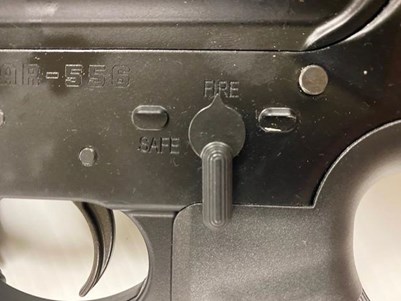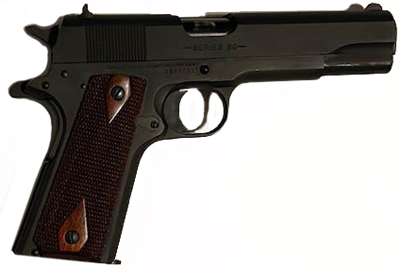
Firearm safeties are designed to prevent a gun from an accidental discharge. Safeties come in a variety of types and shapes, and each is engaged and disengaged in a different manner. They can be in the form of buttons, switches, slides or hammer positions. They can also be found on the firearm’s trigger guard, receiver or bolt. Knowing the location and how to operate the safety on the firearm you are using is critical.
When teaching firearm safety, I never use absolutes. This means that except for when talking about the rules of gun safety, I opt for the word "usually" instead of “always.” Not all safeties work the same way, so it can't be said that a beside-the-bolt safety “always” engages when slid to the rear, because a gun manufactured outside the United States might operate in the opposite direction. Instead, I teach my students that it is their responsibility to know where the safeties on their firearm are located and how to properly engage and disengage them.
Safeties are not foolproof and should never be used to handle any firearm in an unsafe manner. Always follow the rules of gun safety. It is very important to remember that safeties are mechanical devices that can fail. I put a lot of rounds through my training firearms, and I have had to have several safeties repaired by a qualified gunsmith. Just like any mechanical device, the safety can wear out.
Because all responsible gun owners should consistently use their safeties, they should be always make sure that their firearms are in proper working condition—which includes the safeties. Engaging and disengaging a firearm’s safety should be part of training. If you have not practiced disengaging your safety under a stressful and life-threatening situation, you may not be able to defend yourself when the time comes.
Most guns that have safeties are designed to be operated with the right hand. It is for this reason that button safeties on long arms are typically located on the right side and are usually disengaged by pushing the button to the left. Long arms manufactured for left-handed shooters might have the safety on the left side of the firearm and operate in the opposite direction. Safeties on handguns are usually found on the left side of the gun, to be operated by the thumb of the right hand. Handguns manufactured for left-handed shooters might have their safeties on the right side of the gun. Fortunately, many modern pistols are manufactured with ambidextrous safeties that can be operated with either hand.
 Switch Safety
Switch Safety
There are three common switch safeties on rifles and shotguns: the beside-the-bolt safety; on-top-of-the-grip safety; and receiver safety. The beside-the-bolt safety is usually found on the right side of the bolt above the trigger. Usually, sliding this switch rearward engages the safety, and sliding the switch forward disengages the safety. The beside-the-bolt safety is usually found on rifles, and can be operated with the thumb as the shooter is lining up the sights on the intended target.
The on-top-of-the-grip safety can be found on both rifles and shotguns. Most hinge actions utilize this type of safety. Usually, sliding the safety rearward engages the safety and sliding the safety forward disengages it. Some hinge actions automatically slide the safety rearward, engaging the safety, when the action is closed after opening to reload.
The receiver-switch safety is usually found on modern sporting arms (AR-15-style rifles). This safety is typically found on the left side of the receiver. When the switch is rotated to the left, the safety is engaged. When the switch is rotated 90 degrees to the "up" position, the safety is disengaged. There is a third position for Class III automatic firearms. On Class III firearms, the switch is rotated 90 degrees more so that it is pointing toward the rear of the gun to engage the automatic operation.
 Button Safety
Button Safety
Button safeties are usually found on the trigger guard or on the receiver of the firearm. When the button safety is located on the trigger guard, it can be either behind or in front of the trigger. Usually, when pushed to the right, the safety is engaged, and when it is pushed to the left the safety is disengaged. Many times, there is a red ring on the side of the button that disengages the safety to indicate “fire.”
Button safeties can also be found on the receiver of a firearm. Once again, (usually) pushing the button to the right engages the safety and pushing the button to the left disengages it. This is a common safety found on many modern lever-action long arms.
3-Position Tang Safety
The 3-position tang safety is also referred to as a Mauser safety. This type of safety is usually found on rifles that utilize the Mauser action. Modern Winchester Model 70 rifles use a 3-position safety. The 3-position tang safety is found on the rear of the bolt. Usually, when the tang is positioned straight back, the safety is totally engaged and the bolt and firing pin are locked in the safe position. The second or intermediate position is at a right angle to the bolt. In this position, the bolt is unlocked while maintaining the firing pin in the locked position. This allows the bolt to be operated to unload the unfired cartridges is a safe mode. The third position is the fire position that completely disengages the safety. In this position the tang is turned to the forward position.
 Half-Cock Safety
Half-Cock Safety
The half-cock safety is found on rifles with external hammers. Usually, these types of rifles are lever-action rifles. To engage the half-cock safety from the hammer down or the fired position, the shooter uses his or her thumb to pull the hammer back to the first position. This position is approximately ¼ cocked. If the hammer is already in the fully cocked position, the shooter must apply downward pressure on the hammer while pulling the trigger with the index finger of the same hand. The hammer is then slowly allowed to move forward until it locks in the half-cock position approximately ¼ cocked. It is advisable if you have a lever action rifle to put a hammer spur on the hammer. This allows for better control to prevent the hammer from slipping off your thumb and causing an accidental discharge.
Pistol Safety
There are two common types of external safeties on pistols: lever safeties or passive safeties. Lever safeties are usually located on the left side of the pistol near the rear of the slide. On some pistols, such as the 1911, when the lever is up, the safety is engaged. When the lever is pushed down, usually with the shooter’s right-hand thumb, the safety is disengaged.
On some pistols, such as the double-action Berretta 92 FS, when the lever is in the "down" position the safety is engaged, and when the lever is in the "up" position the safety is disengaged. On double-action pistols, this lever also acts as a de-cock lever. So, when a double-action pistol’s hammer is in the cocked position and you want to engage the safety, by pushing the lever up, you de-cock the pistol at the same time you are engaging the safety.
 Passive safeties are found on the backstrap of the pistol grip. When you grip the pistol, the safety is automatically disengaged. This type of safety is designed to prevent an accidental discharge, such as from dropping the firearm. Passive safeties are traditionally found on 1911s but are now on newer model pistols such as the Smith & Wesson striker-fired pistols. This provides the peace of mind of external safeties while maintaining the ability to quickly deploy the pistol if the situation arises.
Passive safeties are found on the backstrap of the pistol grip. When you grip the pistol, the safety is automatically disengaged. This type of safety is designed to prevent an accidental discharge, such as from dropping the firearm. Passive safeties are traditionally found on 1911s but are now on newer model pistols such as the Smith & Wesson striker-fired pistols. This provides the peace of mind of external safeties while maintaining the ability to quickly deploy the pistol if the situation arises.
No matter which firearm you shoot, it is important to be familiar with all kinds of safeties so you’re able to properly handle new or different firearms.














































